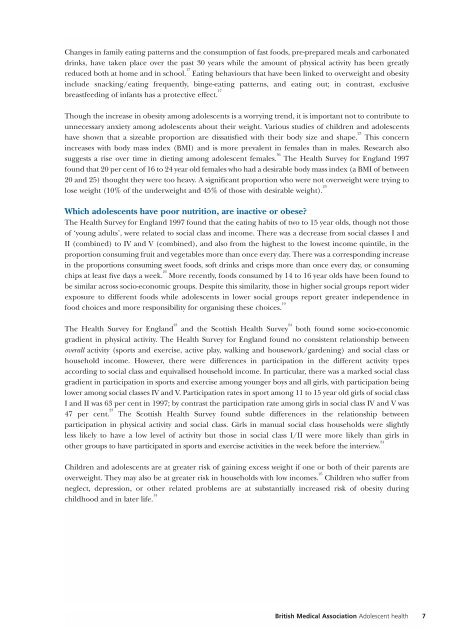Alcohol misuse: tackling the UK epidemic - London
Alcohol misuse: tackling the UK epidemic - London
Alcohol misuse: tackling the UK epidemic - London
Create successful ePaper yourself
Turn your PDF publications into a flip-book with our unique Google optimized e-Paper software.
Changes in family eating patterns and <strong>the</strong> consumption of fast foods, pre-prepared meals and carbonated<br />
drinks, have taken place over <strong>the</strong> past 30 years while <strong>the</strong> amount of physical activity has been greatly<br />
reduced both at home and in school. 17<br />
Eating behaviours that have been linked to overweight and obesity<br />
include snacking/eating frequently, binge-eating patterns, and eating out; in contrast, exclusive<br />
breastfeeding of infants has a protective effect. 17<br />
Though <strong>the</strong> increase in obesity among adolescents is a worrying trend, it is important not to contribute to<br />
unnecessary anxiety among adolescents about <strong>the</strong>ir weight. Various studies of children and adolescents<br />
have shown that a sizeable proportion are dissatisfied with <strong>the</strong>ir body size and shape. 23<br />
This concern<br />
increases with body mass index (BMI) and is more prevalent in females than in males. Research also<br />
suggests a rise over time in dieting among adolescent females. 36<br />
The Health Survey for England 1997<br />
found that 20 per cent of 16 to 24 year old females who had a desirable body mass index (a BMI of between<br />
20 and 25) thought <strong>the</strong>y were too heavy. A significant proportion who were not overweight were trying to<br />
lose weight (10% of <strong>the</strong> underweight and 45% of those with desirable weight). 23<br />
Which adolescents have poor nutrition, are inactive or obese?<br />
The Health Survey for England 1997 found that <strong>the</strong> eating habits of two to 15 year olds, though not those<br />
of ‘young adults’, were related to social class and income. There was a decrease from social classes I and<br />
II (combined) to IV and V (combined), and also from <strong>the</strong> highest to <strong>the</strong> lowest income quintile, in <strong>the</strong><br />
proportion consuming fruit and vegetables more than once every day. There was a corresponding increase<br />
in <strong>the</strong> proportions consuming sweet foods, soft drinks and crisps more than once every day, or consuming<br />
chips at least five days a week. 23<br />
More recently, foods consumed by 14 to 16 year olds have been found to<br />
be similar across socio-economic groups. Despite this similarity, those in higher social groups report wider<br />
exposure to different foods while adolescents in lower social groups report greater independence in<br />
food choices and more responsibility for organising <strong>the</strong>se choices. 19<br />
The Health Survey for England 23<br />
and <strong>the</strong> Scottish Health Survey 24<br />
both found some socio-economic<br />
gradient in physical activity. The Health Survey for England found no consistent relationship between<br />
overall activity (sports and exercise, active play, walking and housework/gardening) and social class or<br />
household income. However, <strong>the</strong>re were differences in participation in <strong>the</strong> different activity types<br />
according to social class and equivalised household income. In particular, <strong>the</strong>re was a marked social class<br />
gradient in participation in sports and exercise among younger boys and all girls, with participation being<br />
lower among social classes IV and V. Participation rates in sport among 11 to 15 year old girls of social class<br />
I and II was 63 per cent in 1997; by contrast <strong>the</strong> participation rate among girls in social class IV and V was<br />
47 per cent. 23<br />
The Scottish Health Survey found subtle differences in <strong>the</strong> relationship between<br />
participation in physical activity and social class. Girls in manual social class households were slightly<br />
less likely to have a low level of activity but those in social class I/II were more likely than girls in<br />
o<strong>the</strong>r groups to have participated in sports and exercise activities in <strong>the</strong> week before <strong>the</strong> interview. 24<br />
Children and adolescents are at greater risk of gaining excess weight if one or both of <strong>the</strong>ir parents are<br />
overweight. They may also be at greater risk in households with low incomes. 25<br />
Children who suffer from<br />
neglect, depression, or o<strong>the</strong>r related problems are at substantially increased risk of obesity during<br />
childhood and in later life. 14<br />
British Medical Association Adolescent health 7
















